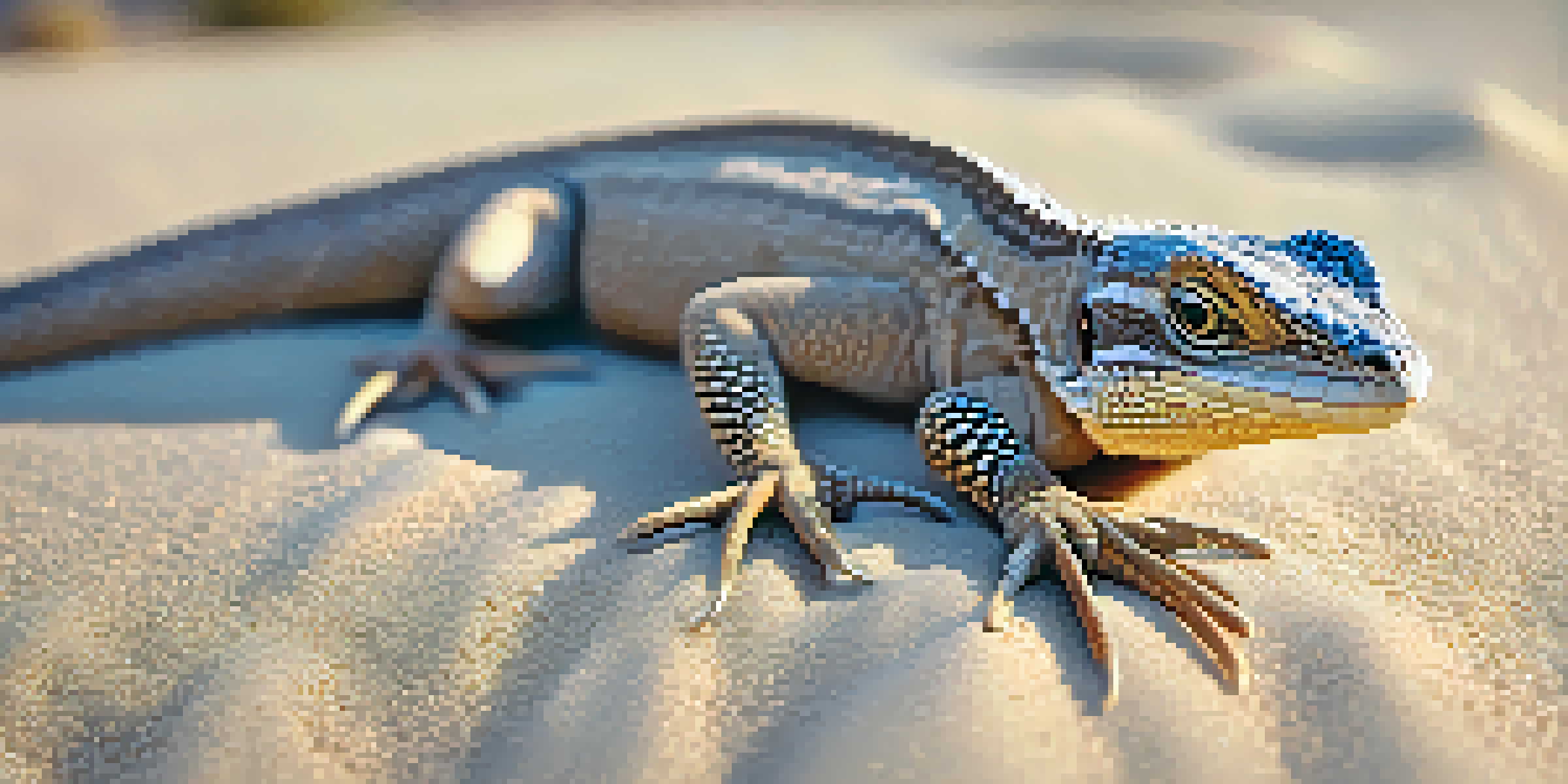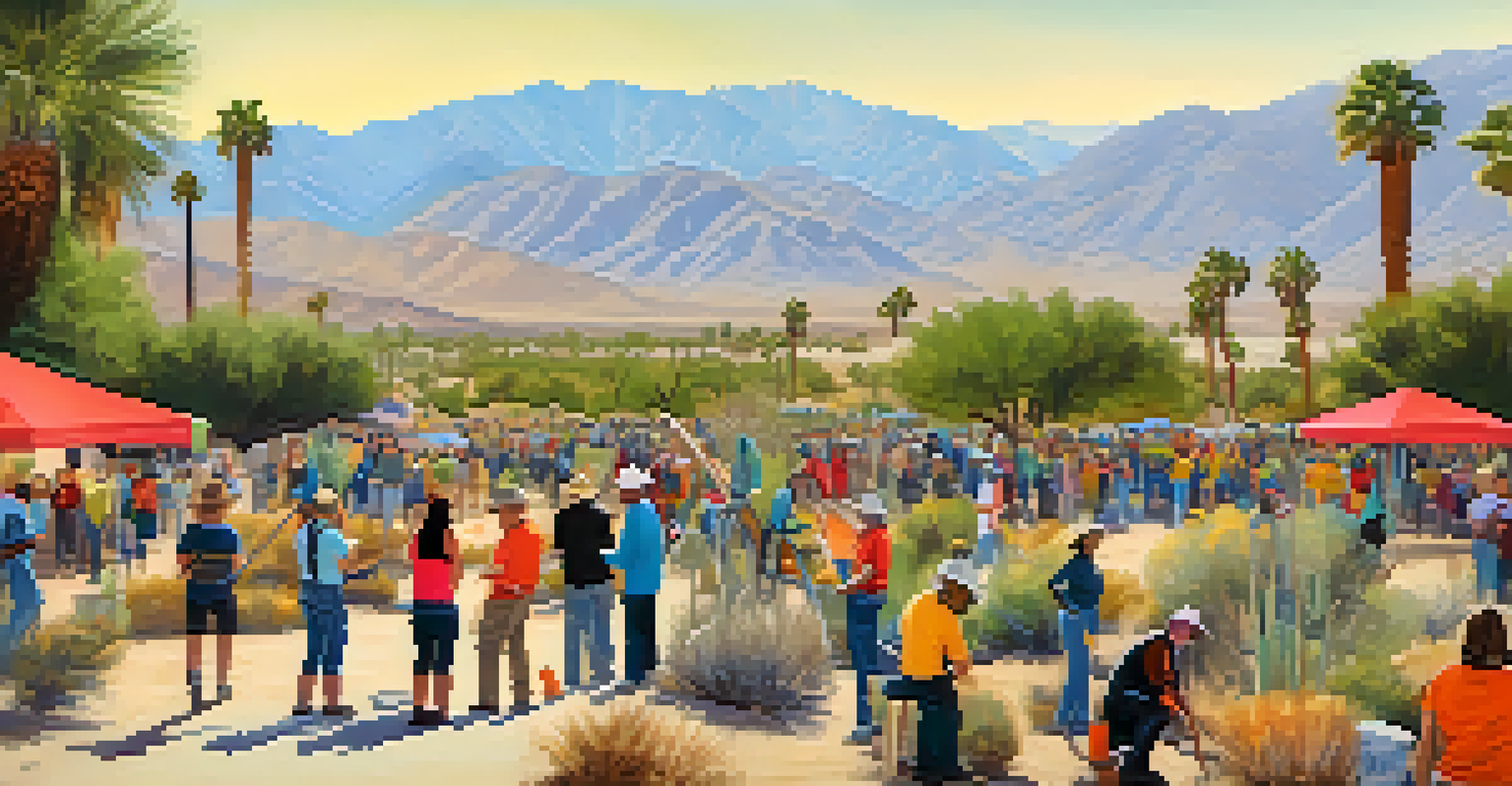Endangered Species in Palm Springs and Conservation Actions

Understanding Endangered Species in Palm Springs
Palm Springs is a beautiful oasis known for its stunning landscapes and diverse wildlife. However, it also harbors several endangered species that are at risk due to habitat loss, climate change, and urban development. Recognizing these vulnerable species is the first step in fostering awareness and promoting conservation efforts.
In nature, nothing exists alone.
Among the endangered species in the region are the Coachella Valley fringe-toed lizard and the bighorn sheep. These unique animals depend on specific habitats that are increasingly threatened by human activity. By understanding their needs and challenges, we can better appreciate their role in the ecosystem and the importance of protecting them.
Conservationists and local organizations are working tirelessly to monitor these species and their habitats. This not only helps us gather vital data but also fosters community engagement, encouraging residents to take part in preserving the natural beauty of Palm Springs.
The Coachella Valley Fringe-Toed Lizard: A Case Study
The Coachella Valley fringe-toed lizard is a small reptile that thrives in sandy desert environments. This lizard is particularly sensitive to changes in its habitat, making it a prime example of the challenges faced by endangered species. With its unique adaptations, it has become a symbol of the conservation efforts in the Palm Springs area.

Unfortunately, urban expansion and off-road vehicle activity have led to habitat fragmentation, which threatens the lizard's populations. Conservation actions, such as habitat restoration and protection, are critical for ensuring the survival of this species. Understanding the lizard's needs can help us create more effective conservation strategies.
Endangered Species Need Our Help
Palm Springs is home to endangered species like the Coachella Valley fringe-toed lizard and bighorn sheep, highlighting the urgent need for conservation efforts.
Community involvement plays a crucial role in the success of these efforts. Educating residents about the importance of preserving the fringe-toed lizard's habitat can lead to more sustainable practices and greater support for conservation initiatives.
Bighorn Sheep: Majestic Creatures at Risk
Bighorn sheep are iconic to the mountainous regions around Palm Springs, known for their impressive horns and agile climbing abilities. However, these magnificent animals face significant threats, including habitat loss and diseases from domestic livestock. Their population decline calls for immediate attention and proactive conservation measures.
The future will be shaped by the choices we make today.
One of the key conservation strategies is creating wildlife corridors that connect fragmented habitats. This allows bighorn sheep to move freely between areas, reducing inbreeding and promoting genetic diversity. Such initiatives not only benefit the sheep but also enhance the overall health of the ecosystem.
Engaging the local community is essential in these conservation efforts. By organizing educational programs and wildlife viewing tours, residents can gain a greater appreciation for bighorn sheep and the need to protect their habitat, fostering a culture of conservation.
The Role of Local Organizations in Conservation
Local organizations play a pivotal role in the conservation of endangered species in Palm Springs. Groups such as the Coachella Valley Conservation Commission and the Desert Wildlife Unlimited are dedicated to protecting wildlife and their habitats. Through research, advocacy, and education, these organizations work tirelessly to promote conservation efforts.
Volunteers from the community often join these organizations to assist in various projects, including habitat restoration and monitoring endangered species. This collective effort not only helps the animals but also strengthens community ties and increases awareness about the importance of biodiversity.
Community Engagement is Key
Local organizations and community involvement are crucial for raising awareness and implementing effective conservation strategies.
By supporting local organizations, residents can contribute to meaningful change. Whether through donations, participation in events, or spreading the word, each action helps in the fight to protect endangered species in Palm Springs.
Educating the Public on Endangered Species
Public education is a key component of successful conservation efforts. By raising awareness about the endangered species in Palm Springs, we can inspire individuals to take action. Workshops, school programs, and community events can effectively convey the importance of biodiversity and the threats these species face.
Additionally, utilizing social media platforms can amplify these educational efforts. Engaging content, such as infographics and videos, can reach a wider audience and encourage discussions about conservation. The more people know about the challenges endangered species face, the more likely they are to support conservation initiatives.
Ultimately, fostering a sense of responsibility within the community can lead to lasting change. When individuals understand the impact of their actions on local wildlife, they are more inclined to adopt sustainable practices that benefit the environment.
Supporting Conservation Through Sustainable Practices
Adopting sustainable practices is vital for the conservation of endangered species in Palm Springs. Simple changes in daily habits, such as reducing water usage and minimizing plastic waste, can have a significant positive impact on local ecosystems. Every small effort counts in the larger picture of conservation.
Moreover, supporting local businesses that prioritize sustainability can create a ripple effect throughout the community. When consumers choose eco-friendly products and services, it encourages other businesses to adopt similar practices. This collective shift can help protect the habitats of endangered species.
Sustainable Practices Matter
Adopting sustainable practices in daily life can significantly contribute to the conservation of endangered species and their habitats in Palm Springs.
By promoting sustainable tourism, visitors to Palm Springs can enjoy the beauty of the desert while contributing to conservation efforts. Eco-tours and responsible wildlife observation can ensure that local wildlife is respected and protected, fostering a greater appreciation for the region's unique biodiversity.
The Future of Endangered Species in Palm Springs
The future of endangered species in Palm Springs depends on our collective commitment to conservation. With ongoing efforts from local organizations, community engagement, and education, there is hope for the survival of these unique creatures. By fostering a culture of conservation, we can ensure that future generations will also be able to enjoy the beauty of the desert.
Technological advancements, such as habitat monitoring drones and genetic research, are also playing a crucial role in conservation strategies. These tools can provide valuable insights into the behavior and needs of endangered species, allowing for more effective management plans.

Ultimately, the responsibility lies with all of us. By remaining informed and actively participating in conservation efforts, we can make a difference in protecting the endangered species that call Palm Springs home.
How You Can Get Involved in Conservation
Getting involved in conservation doesn’t have to be overwhelming; there are many ways individuals can contribute. One effective method is to volunteer with local organizations dedicated to protecting endangered species. Whether it’s participating in clean-up events or helping with wildlife monitoring, every effort makes a difference.
Additionally, advocating for policies that protect local wildlife can amplify your impact. Engaging with local government officials and sharing your concerns about conservation can lead to positive changes at the policy level. It’s important for community voices to be heard in discussions about land use and development.
Lastly, spreading the word about the importance of conservation among friends and family can inspire others to take action. Creating a network of environmentally conscious individuals can lead to a more significant collective effort in protecting the endangered species in Palm Springs.